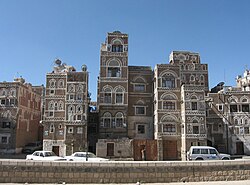
Yemen is an Arab country in Western Asia at the southern end of the Arabian Peninsula. It was also historically referred to as Southern Arabia or Arabia Felix, which translates to Happy Arabia in Latin. As of 2013, the country had a GDP (ppp) of US$92.8 billion, with an income per capita of $5,000. Services are the largest economic sector (61.4% of GDP), followed by the industrial sector (30.9%), and agriculture (7.7%). Of these, petroleum production represents around 25% of GDP and 63% of the government's revenue. [1]
Contents
Yemen's industrial sector is centered on crude oil production and petroleum refining, food processing, handicrafts, small-scale production of cotton textiles and leather goods, aluminum products, commercial ship repair, cement, and natural gas production. As of 2013, Yemen had an industrial production growth rate of 4.8%. [1] It also has large proven reserves of natural gas. [2] Yemen's first liquified natural gas plant began production in October 2009.


